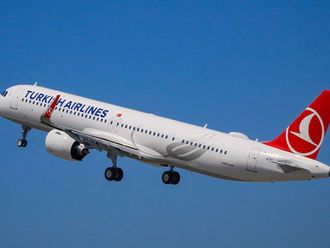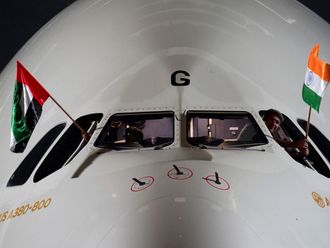Dubai: Middle East carriers are expected to see profits of $400m (down from the previously forecast $800m) due to high fuel costs, the the International Air Transport Association said Wednesday.
The IATA said the change was due to squeezed profit margins on the more price sensitive long-haul traffic connecting over Middle Eastern hubs.
IATA made Wednesday's revised industry outlook for 2011, saying "profitability remains weak but unchanged at $6.9 billion for a net margin of 1.2 per cent".
Looking ahead to 2012, IATA downgraded its central forecast for airline profits from $4.9 billion to $3.5 billion for a net margin of 0.6 per cent.
The Eurozone crisis puts severe downside risk on the 2012 outlook as illustrated by the recently published OECD economic outlook.
In a worst case scenario, should the Eurozone crisis evolve into a full-blown banking crises and European recession, IATA estimates that the global aviation industry could suffer losses exceeding $8 billion in 2012.
"The biggest risk facing airline profitability over the next year is the economic turmoil that would result from a failure of governments to resolve the Eurozone sovereign debt crisis. Such an outcome could lead to losses of over $8 billion — the largest since the 2008 financial crisis," said Tony Tyler, IATA's Director General and CEO.
"The global forecast for 2011 is unchanged at $6.9 billion. But regional differences have widened, reflecting the very different economic environments facing airlines in different parts of the world. And the overall margin of 1.2 per cent tells you just how difficult the battle for profitability in this business is," said Tyler.
European carriers are by far in the most challenging position. Higher passenger taxes and weak home market economies have limited profitability in Europe.
The region's carriers are forecast to generate a collective profit of just $1.0 billion, down from the previously forecast $1.4 billion, and an EBIT margin of 1.2 per cent.
Low profitability has been despite European airlines being one of the fastest growing regions in terms of traffic this year. Yields have suffered and the base of strong demand grows more fragile as the sovereign debt crisis escalates.
North American carriers are in a much more benign environment. They have seen yield and load factor improvements as a result of tight capacity management, which has improved profitability to $2.0 billion (up from the previously forecast $1.5 billion).
The US economy has also grown at a faster pace than Europe. This gives the region the strongest EBIT margin of 3.2 per cent.
Nonetheless, the bankruptcy filing of American Airlines indicates that the region faces intense competitive challenges as well.
Asia-Pacific carriers also saw stronger though varied trading conditions. Japan's domestic market still has not fully recovered from the March earthquake and tsunami, and load factors remain under pressure.
By contrast airlines have improved load factors and profitability on China's expanding domestic market. We have upgraded our forecast for the region by $800 million to a $3.3 billion profit. This is the largest absolute profit among the regions.
Middle East carriers are expected to see profits of $400m (down from the previously forecast $800m) as high fuel costs squeezed profit margins on the more price sensitive long-haul traffic connecting over Middle Eastern hubs.
In a similar pattern Latin American profits will see a downgrade to $200m (from the previously forecast $600m). Performance has been mixed across the region with much of the downgrade due to the impact of intense competition and falling load factors on Brazil's domestic market.
African carriers are still expected to break-even. New trade lanes with Asia are developing and markets within the continent are reflecting the improvement in economic development in many African economies. However, competition has been fierce and the region's airlines have struggled to keep load factors at profitable levels.
At the global level, passenger demand is expected to expand by 6.1 per cent which is stronger than the 5.9 per cent forecast in September.
Air travel growth has persisted at a stronger pace than we had expected. This travel strength, along with tight capacity management, particularly in North America, has kept load factors high and is supporting a 4.0 per cent increase in yields.
This has helped a modest increase in forecast revenues, which we expect to total $596 billion this year. This slightly stronger-than-expected passenger performance is offsetting (1) worse-than-expected cargo performance and (2) somewhat higher-than-anticipated oil prices.
At an average oil price of $112 per barrel, the industry's 2011 fuel bill is expected to be $178 billion (up $2 billion from previous expectations). A downward trend in cargo since mid-year means that cargo likely will finish the year with a 0.5 per cent contraction in volumes and flat yields.












